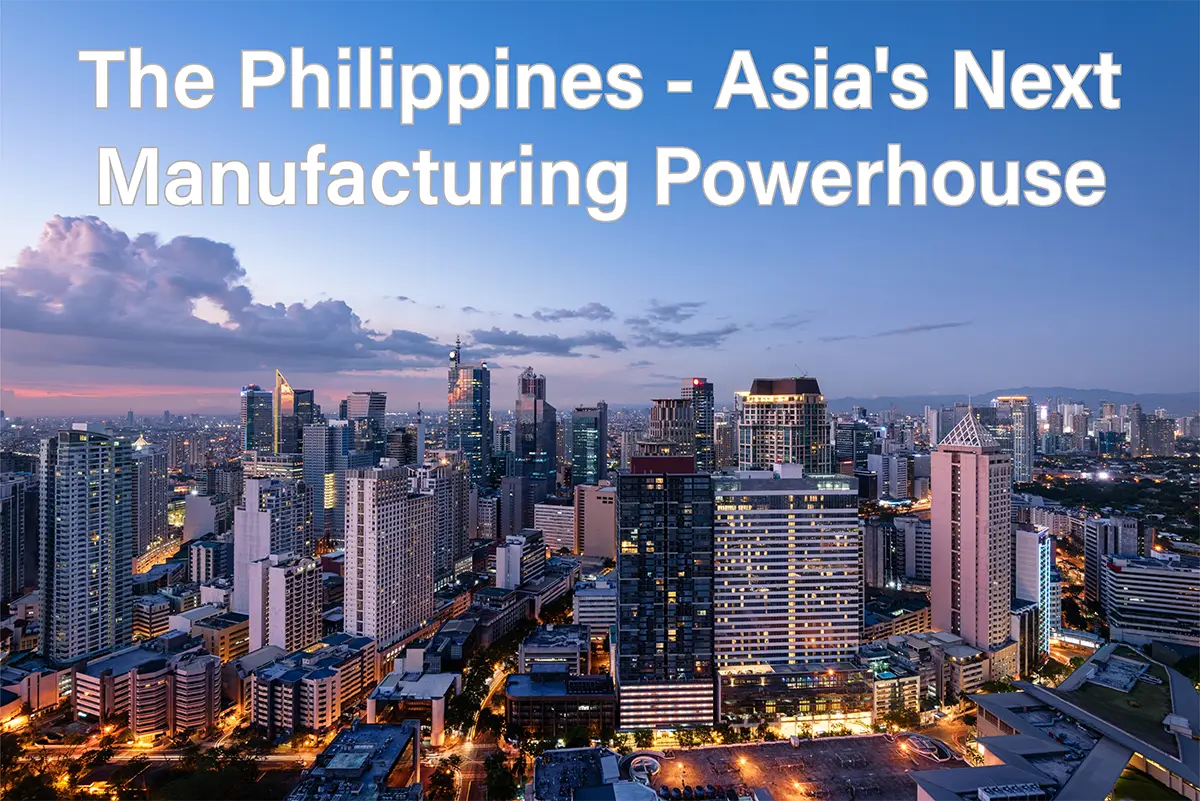Beyond China: Exploring the Philippines as Your Manufacturing Solution
Tariffs are a hot topic worldwide. The trade war between the US and China is the primary focus, but as two major players in the global economy, its effects could soon be felt elsewhere.
China is the world’s top exporter. However, its status as the world’s factory is more recent than its breadth may suggest. Before 1978, China operated under a centrally run economy. In 1978, widespread economic reforms created Special Economic Zones to attract foreign investment. Foreign countries began outsourcing to China, and 32 years later, the country that had very little international trade surpassed the United States to become the top manufacturer in the world.

China has been a reliable manufacturing option for the last half-century; providing low labour costs and a strong manufacturing infrastructure. However, with so much uncertainty in the global economy, some companies are looking for alternatives. Beyond the possibility that the UK/China trade relationship could see raised tariffs, global supply chains that run through China and the US incur tariffs. One alternative electronics manufacturers in the UK should consider doesn’t even require leaving the South China Sea — the Philippines.
Manufacturing in the Philippines
Tariffs are not the only reason manufacturing in the Philippines has an economic advantage for international companies. The Philippines offers low labour costs and a stable economy, resulting from the country’s shift toward upper-middle income status. The government also supports a growing manufacturing sector through the Manufacturing Resurgence Program and PEZA special economic zones. The Manufacturing Resurgence Program seeks to expand industry capacity by addressing supply chain gaps. PEZA zones are designated economic zones for foreign investments. These zones provide assistance, grant incentives, and aid business operations of investors in export-oriented manufacturing. Companies can also get long-term land leases in PEZA zones for up to 75 years.
A Skilled Workforce
As the Philippines grows as a manufacturing destination, it is already a Business Process Outsourcing (BPO) industry leader. Countries have outsourced remote tasks to the Philippines, adding about £22.5 billion to the Philippine economy each year. The Philippines’ location, combined with its skilled workforce and high rate of English proficiency, makes it a desirable location for manufacturing outsourcing, not just remote work.
VAT and Tariffs
Like most other countries, the Philippines has a VAT system. The Philippines’ VAT rate is set at 12%. However, companies that export over 70% of their annual production are eligible for zero-rated VAT.
Manufacturing within PEZA zones offers additional VAT incentives, including tax- and duty-free importation of capital equipment and raw materials and VAT exemptions on importation. Eligible PEZA export manufacturing activities include manufacturing, assembly, and processing.
Potential Challenges
Due to its location and more recent investment in the manufacturing sector, the Philippines faces some potential challenges in manufacturing. When it comes to infrastructure, the Philippines has more limitations than established manufacturing powerhouses like China. As an island nation, the Philippines is also vulnerable to tropical cyclones that could disrupt business operations. Exporters in the Philippines must register in the Client Profile Registration System (CPRS) and obtain an export license and certificate of origin.
Manufacturing in the United States
The Philippines offers low labour costs, tax incentives, and special economic zones for manufacturing and assembly. However, its location and infrastructure limitations may be holdbacks for some manufacturers. For companies that prioritize these factors, the US is a viable alternative.
Economic Advantages
As a leader in Industry 4.0, the United States can manufacture advanced technology in the centre of a large consumer market. Companies can save on transportation of end products and achieve faster delivery times to the North American market. Additionally, as the US remains a hotspot for changing tariffs, manufacturing products in the US avoids potential added costs.
Quality
As mentioned, the US has advanced manufacturing capabilities and is a leader in smart manufacturing. Machine learning and strong quality control procedures both contribute to the quality of US-produced products. The US also ranks first in the world in IP protection, which gives companies a competitive advantage since copycat products must be licensed by the original company.
VAT and Tariffs
The US is one of the few countries in the world without a VAT system. However, the US does use tariffs to protect certain industries, such as automobiles, which are currently subject to a 10% tariff on the first 10,000 units, then a 25% tariff on additional vehicles exported from the UK. The US-UK trade deal, which reduced tariffs, was followed by a ruling that, at the time of this article, has blocked a blanket 10% tariff on UK goods. However, as has been the case throughout 2025, the future of international trade in the United States remains unclear.
Potential Challenges
Manufacturing in the US saves money on transportation costs. However, the higher labour costs compared to China and the Philippines mean that companies must evaluate which location makes the most financial sense in the long run. Additionally, the US’s reliance on imported components could make supply chains vulnerable to disruptions or price fluctuations. Finally, while the high regulatory standards in the US lend themselves to superb operations and products, navigating these regulations can be complex.
Manufacturing in China
Even before the enactment of new tariffs, some companies had already relocated out of China. Rising labour costs prompted companies with labour-intensive manufacturing practices to relocate. The US-China tariffs impacted supply chains; if any part of the supply chain includes transport between the US and China, the materials will be subject to tariffs. At the time of this article, the US and China reached a temporary agreement to reduce tariffs, though industry commentators are wary of the perceived fragility of the deal.
Additionally, suppliers may adjust distribution and shipping to avoid tariffs. Altogether, these factors are causing companies to reshore or move manufacturing operations elsewhere. Other countries, such as the Philippines, are catching up to China’s production capabilities, providing more options for manufacturers.
Philippines vs. US Manufacturing
Where to manufacture is a big decision. Cost, type of manufacturing, transportation, and supply chains are all critical factors to consider when choosing a manufacturing destination.
Take the Philippines and the US, for example. The Philippines is ideal for labour-intensive electronics manufacturing — labour costs are low, and there is a skilled workforce. Alternatively, the US is highly automated, making it an attractive option for large-scale automated assembly.
Beyond the actual manufacturing process, supply chains and transportation are also deciding factors in where to manufacture. The US has more robust supply chains due to its strong transportation system. However, tariffs on components imported from other countries could create added complexity for companies. On the other hand, the Philippines is more resistant to tariffs, but natural disasters could have a greater impact on supply chains if ports are temporarily shut down.
Manufacturers must weigh various economic factors when choosing where to establish operations. While China has long been the dominant force, rising tariffs, labour costs, and supply chain risks are pushing companies to explore alternative manufacturing destinations.
The Philippines and the United States each offer distinct advantages — from the Philippines’ cost-effective, labour-rich environment and tax incentives, to the US’s advanced automation capabilities, IP protections, and favourable location. The correct manufacturing location depends on your product type, target market, and long-term strategy. By looking beyond China and considering emerging players like the Philippines or technologically advanced hubs like the US, manufacturers can build more resilient and cost-effective supply chains in an increasingly unpredictable global landscape.
Pivot UK is the European headquarters for Pivot International. Our cross-functional teams work with partners to develop their products from concept to market. We meet our partners’ needs with global manufacturing options, including sites in the Philippines, the US, Mexico, and China. Our largest facility, Pivot-Hawks Manila, offers over 7,000 square meters of manufacturing space and mirrored SMT lines with EDM, one of our US sites. Contact us today to learn more about how Pivot can help bring your product to market.

